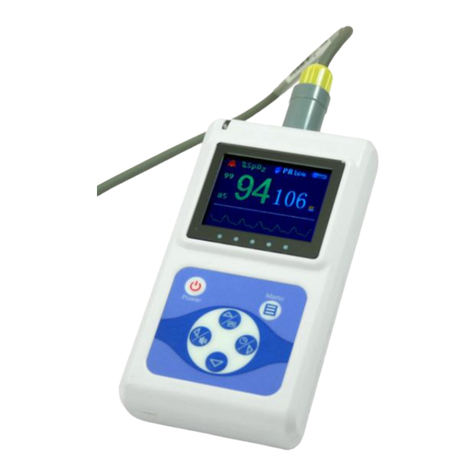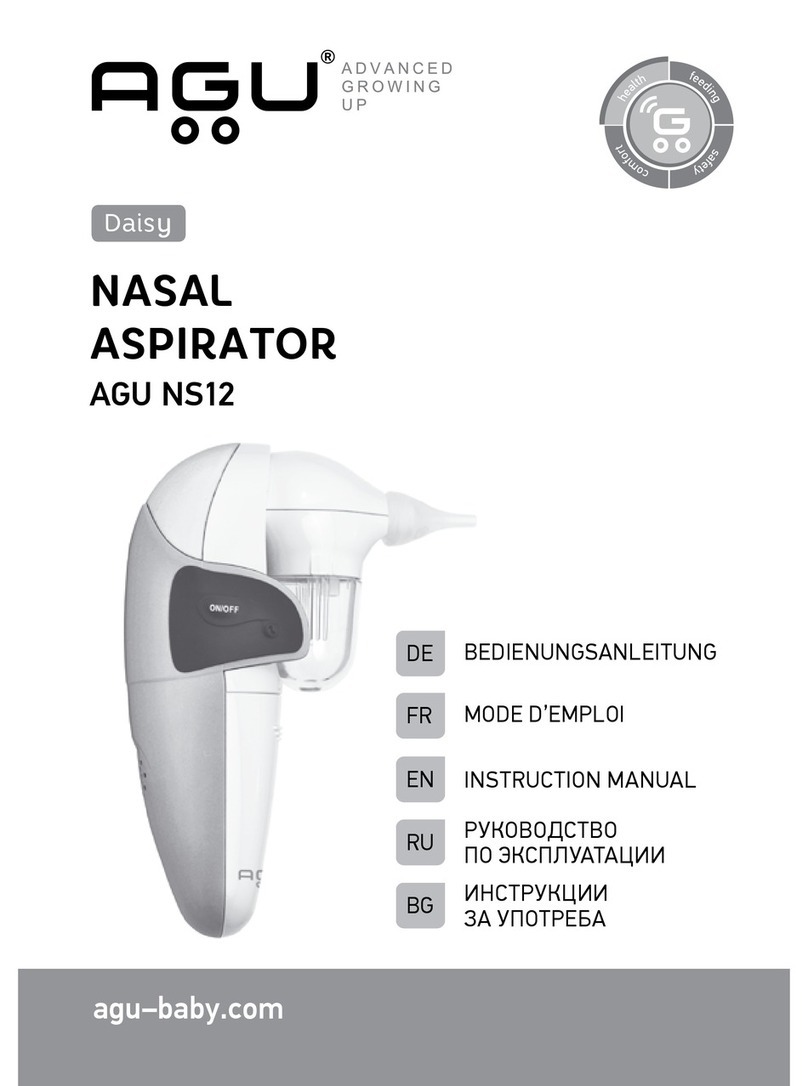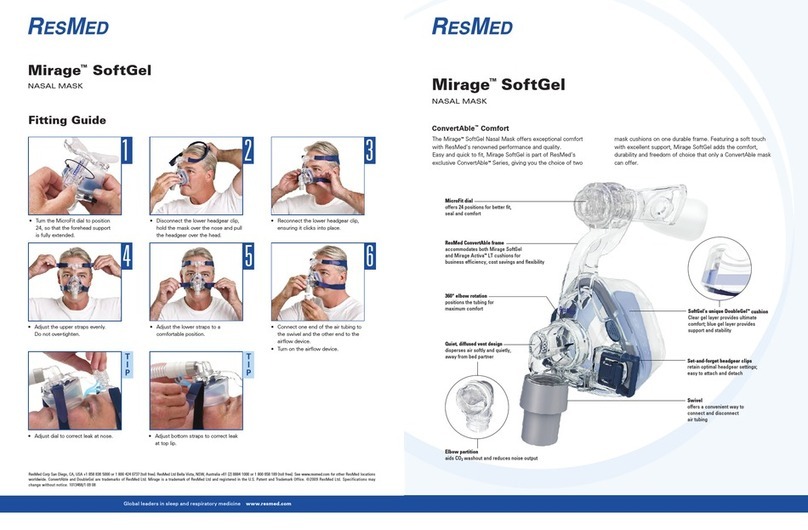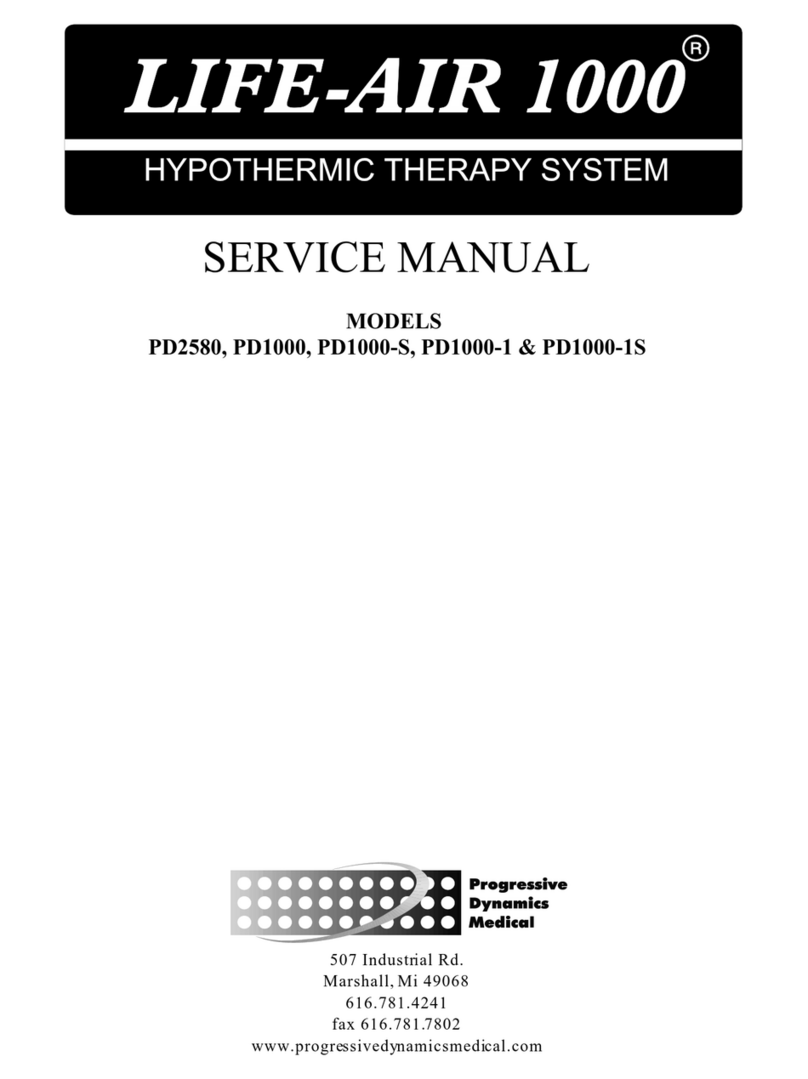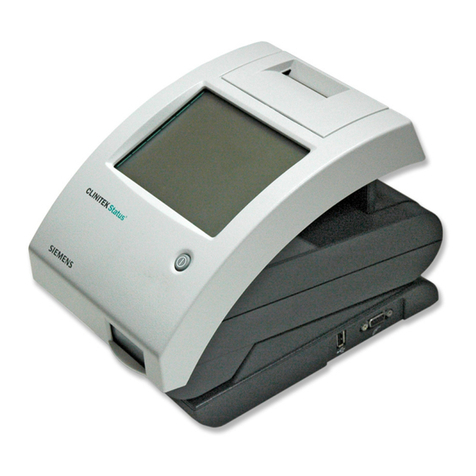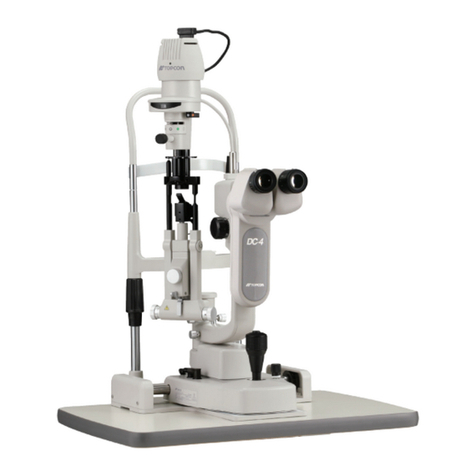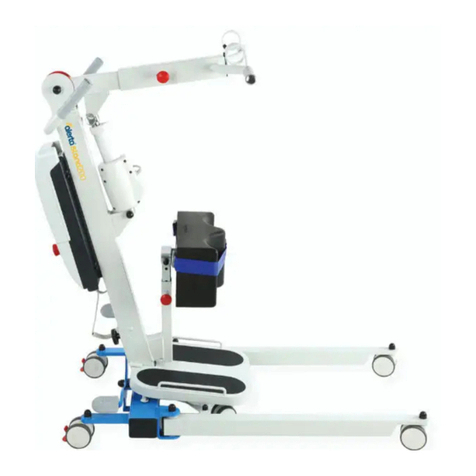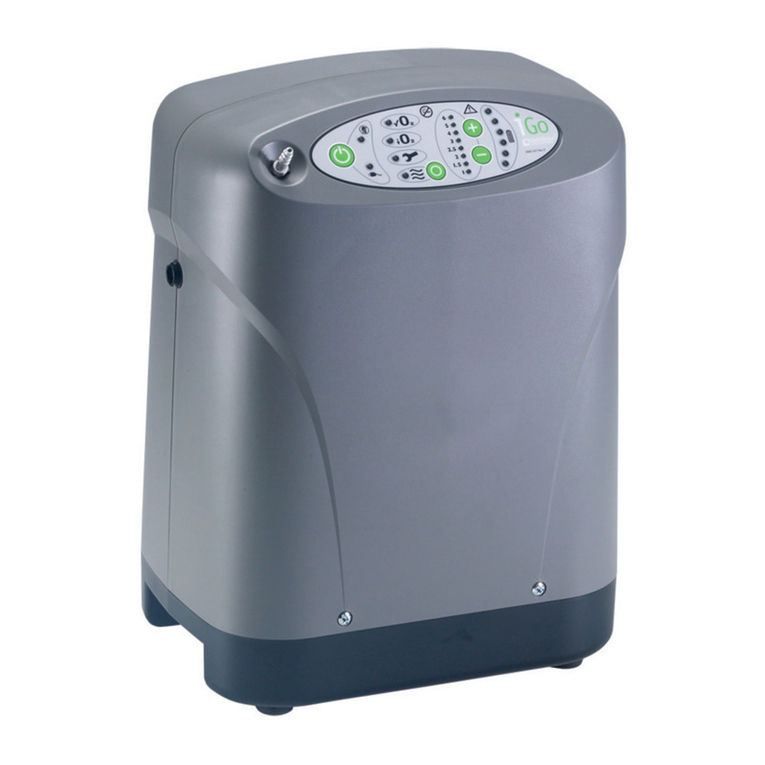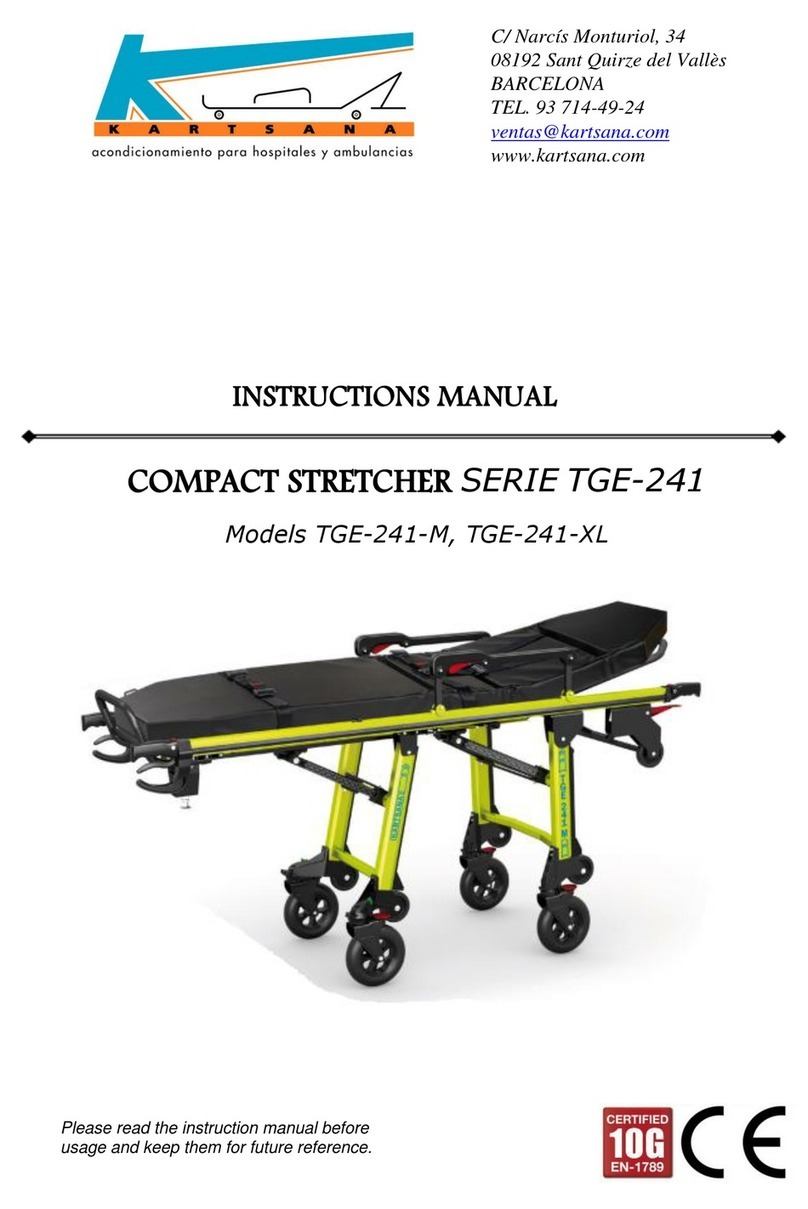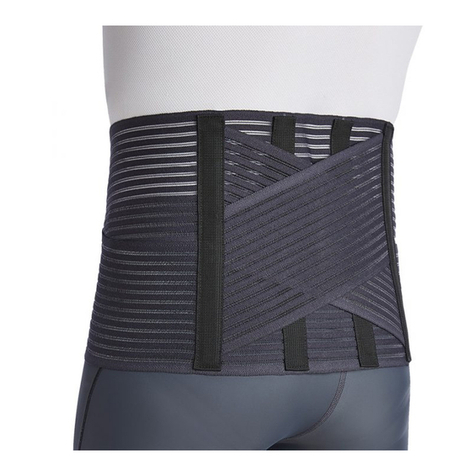Hasomed RehaStim 2 User manual

Operation Manual RehaStim 2, RehaMove 2
Hasomed GmbH
Version 2.4 / 2016-10
User Guide

I
HASOMED GmbH
Operation Manual RehaStim2, RehaMove2
Table of Contents
Part 1 General Description 1
........................................................................................................................ 11 Declaration of Conformity
........................................................................................................................ 22 Description of the RehaStim2
........................................................................................................................ 23 Warnings and Precautions
........................................................................................................................ 54 Indications and Contra Indications
........................................................................................................................ 75 User Safety
........................................................................................................................ 96 Adverse Reactions
........................................................................................................................ 97 Default Values and Adjustment Ranges of Stimulation Parameters
......................................................................................................................................................... 9Technical Specifications
......................................................................................................................................................... 12Default Values
......................................................................................................................................................... 13Features
........................................................................................................................ 138 Maintenance and Service Instructions
Part 2 What's new in this Software Version? 14
Part 3 Device Controls and Accessories 15
........................................................................................................................ 151 Controls
........................................................................................................................ 162 Accessories
Part 4 General Settings and Service Information 20
........................................................................................................................ 201 Information: Licence & Firmware, Memory, Language
........................................................................................................................ 212 System: Device Settings, Backup & Restore, Password
........................................................................................................................ 243 MOTOmed: Reference Angle, FES3 Protocol, FES3 Test
........................................................................................................................ 264 Mounting Instruction for Stimulation Bracket
........................................................................................................................ 305 Mounting Instruction for Power Supply Holder
Part 5 RehaMove2-FES Cycling 31
........................................................................................................................ 311 Notes on the Therapy with RehaMove2
........................................................................................................................ 322 Safety Measures before you start
........................................................................................................................ 323 Clinical Use
......................................................................................................................................................... 33Recommended Adjustments
......................................................................................................................................................... 33Using 2 or more RehaMove2: Client individual USB Flash Drive
........................................................................................................................ 344 Home Use
......................................................................................................................................................... 34Recommended Adjustments
........................................................................................................................ 355 Data Storage in the Stimulator
........................................................................................................................ 366 RehaMove Training - Integrated Operation (FES 3-Interface)
......................................................................................................................................................... 37Create new Users and new User Profiles, import old Profiles
......................................................................................................................................................... 42Edit or delete a User Profile
......................................................................................................................................................... 45Constant Stimulation Training

IIInhalt
HASOMED GmbH
......................................................................................................................................................... 50Adaptive Stimulation Training
......................................................................................................................................................... 52Templates for common Muscle Combinations in LegTraining
......................................................................................................................................................... 53Templates for common Muscle Combinations in Arm Training
......................................................................................................................................................... 54Details about the Feedback Screens
......................................................................................................................................................... 56Access TrainingHistory after Session is finished
......................................................................................................................................................... 58Access Training History
......................................................................................................................................................... 60Finishing a Stimulation Session
......................................................................................................................................................... 60RehaMove PC Software
........................................................................................................................ 647 RehaMove Letto2
........................................................................................................................ 648 RehaMove2 for Children: RehaMove2 Gracile
Part 6 General Stimulation/ Sequence Mode 65
........................................................................................................................ 651 Notes on the Therapy with the Sequence Mode
........................................................................................................................ 652 Safety Measures
........................................................................................................................ 663 Create new Users and new Profiles
........................................................................................................................ 704 Operation
........................................................................................................................ 715 Templates for common Muscle Combinations in Sequence Mode
......................................................................................................................................................... 71Arms
......................................................................................................................................................... 73Legs
......................................................................................................................................................... 75Torso
......................................................................................................................................................... 78Stepping
........................................................................................................................ 806 External Trigger
......................................................................................................................................................... 80Adjusting the external single Trigger
......................................................................................................................................................... 82Adjusting the external double Trigger
........................................................................................................................ 837 Edit or delete a User Profile, show Training History
........................................................................................................................ 838 Finishing a Stimulation Session
Part 7 Fault Indication 84
Part 8 Declaration of Warranty 87
Part 9 Address of Manufacturer 88

HASOMED GmbH
Operation Manual RehaStim2, RehaMove21
Version 2.4 / 2016-10
1 General Description
1.1 Declaration of Conformity

General Description
HASOMED GmbH
2
Version 2.4 / 2016-10
1.2 Description of the RehaStim2
The RehaStim2 is a portable electrical stimulation device that generates impulses, on up
to 8 channels simultaneously, to activate paralysed muscles via surface electrodes. The
RehaStim2 can be used as a portable (contains a battery) or stationary device for
training and rehabilitation applications. It can be used on its own or in combination with
a motion trainer as RehaMove2. Numerous parameters concerning power and temporal
sequence of the impulses can be adjusted individually for each channel.
The parameters and operational conditions are presented on a big graphical display
making it easy to interact with the device. The operation of the device happens via
pressure-sensitive buttons and a rotary switch.
The stimulator can generally be applied to functional electrical stimulation tasks of all
kinds. In addition, the stimulator software and hardware have been especially prepared
for a specific rehabilitation system as RehaMove2 using a motion trainer.
The RehaStim2 stimulator is certified according to the international standards EN
60601-1 and EN 60601-2-10 for medical technical devices and systems.
1.3 Warnings and Precautions
Executive Safety Summary
I. CONTRAINDICATION
1. Powered muscle stimulators should not be used on patients with cardiac demand
pacemakers.
II. WARNINGS
1. The long-term effects of chronic electrical stimulation are unknown.
2. Stimulation should not be applied over the carotid sinus nerves, particularly in
patients with a known sensitivity to the carotid sinus reflex.
3. Stimulation should not be applied over the neck or mouth. Severe spasm of the
laryngeal and pharyngeal muscles may occur and the contractions may be strong
enough to close the airway or cause difficulty in breathing.
4. Stimulation should not be applied transthoracically in that the introduction of
electrical current into the heart may cause cardiac arrhythmias.
5. Stimulation should not be applied transcerebrally.
6. Stimulation should not be applied over swollen, infected, or inflamed areas or skin
eruptions, e.g., phlebitis, thrombophlebitis, varicose veins, etc.
7. Stimulation should not be applied over, or in proximity to, cancerous lesions.

HASOMED GmbH
Operation Manual RehaStim2, RehaMove23
Version 2.4 / 2016-10
III. Further Warnings
1. Do not use when user is simultaneously connected to a highfrequency surgical unit,
because this may lead to burns underneath the electrodes.
2. Do not use near (within 1 m) devices with high frequency (HF) range or micro- and
short-wave devices or welding units.
3. Do not exceed 0,1 watts/cm2. Current densities at the electrodes exceeding 2 mA/cm2
may require the special attention of the OPERATOR.
4. Adjust the stimulator according to the user manual or/and the instructions of your
clinician.
5. No modification of this equipment is allowed. Unexpected hazards (for instance
electrical shock, unintended misuse, mechanical hazards) can result from
unauthorized modification.
IV. PRECAUTIONS
1. Safety of powered muscle stimulators for use during pregnancy has not been
established.
2. Caution should be used for patients with suspected or diagnosed heart problems.
3. Caution should be used for patients with suspected or diagnosed epilepsy.
4. Caution should be used in the presence of the following:
a. When there is a tendency to hemorrhage following acute trauma or fracture;
b. Following recent surgical procedures when muscle contraction may disrupt the
healing process;
c. Over the menstruating or pregnant uterus; and
d. Over areas of the skin which lack normal sensation.
5. Some patients may experience skin irritation or hypersensitivity due to the electrical
stimulation or electrical conductive medium. The irritation can usually be reduced by
using an alternate conductive medium, or alternate electrode placement.
6. Electrode placement and stimulation settings should be based on the guidance of the
prescribing practitioner.
7. Powered muscle stimulators should be kept out of the reach of children.
8. Powered muscle stimulators should be used only with the leads and electrodes
recommended for use by the manufacturer.
9. [FOR PORTABLE DEVICES ONLY]: Portable powered muscle stimulators should not be
used while driving, operating machinery, or during any activity in which involuntary
muscle contractions may put the user at undue risk of injury.
V. ADVERSE REACTIONS
Skin irritation and burns beneath the electrodes have been reported with the use of
powered muscle stimulators.
Read the manual carefully before using this device! The RehaStim2 is classified as a
medical device type IIa.
An inspection of the device must be carried out by the HASOMED service staff only. You
are not allowed to open the device. The repair of the RehaStim2 must be performed by
the manufacturer only!
CAUTION! The accumulator integrated in the device must only be replaced by the
HASOMED service staff! If the accumulator is replaced without permission, no guarantee
for a secure operation is given!
The proper disposal of such device (LI-ION battery) involves certain risks. You can avoid
these risks by returning the device to HASOMED GmbH. The separate battery charger is

General Description
HASOMED GmbH
4
Version 2.4 / 2016-10
part of the system and must not be replaced with a different type. You are recommended
that the charger undergoes a regular check-up and is replaced if necessary.
If the documentation is not clear about the use of this device in
a particular way or the connection of this device to another
device, please contact the manufacturer or an expert to ensure
that the user's safety is not put at risk.
In the USA, Federal Law restricts the device to sale by, or on
the order of, a physician or other practitioner licensed to use
the device.
If the device is used in combination with the movement therapy machine as part of the
RehaMove2 system, only the provided connection parts (cables, electrodes etc.) must be
used.
If the patient’s blood pressure or heart rate reaches a level that the clinician considers
a compromise to safety, or if the patient feels fainted or nauseated, the session should
be stopped immediately and appropriate medical action should be taken. If the patient
begins to feel light-headed or bad, stop the treatment immediately.
Some medical conditions can be aggravated by physical activity. If symptoms of a
medical condition occur during or after a therapy session, consult your clinician
immediately.
If directed by the clinician, the client’s blood pressure and heart rate should be
monitored during the therapy session.
Electrode placement and stimulation settings should be based on the guidance of the
prescribing practitioner.
Powered muscle stimulators should be kept out of the reach of children. Children
should only use this device under adult supervision. Never leave the RehaMove2
unattended when children are present.
The device presents a hazard to infants and small children, even if it is turned off. To
prevent possible strangulation (e.g. with the cables) or suffocation (e.g. with small
parts), ensure that children always stay under adult supervision when moving near the
device.
The arm crank should not be used unless continuous assistance is available as while
using this device it may not be possible for the client to stop the therapy while their
arm(s) / hand (s) are secured.

HASOMED GmbH
Operation Manual RehaStim2, RehaMove25
Version 2.4 / 2016-10
Safety instructions for electrode use:
Skin must always be clean, dry and free from lotion. When
Electrodes begin losing adhesion, gently rubbing of one or two
drops of water onto gel surface (Re-hydrate Gel) may extend
usage. If not, replace with new electrodes.
Do not apply to open skin! Should a skin rash or a skin burn
occur, discontinue use immediately and contact your clinician.
Do not stimulate while driving or operating machinery!
For your safety and comfort, turn off the stimulator before you attempt to remove
electrodes from your skin.
Always lift electrodes from the edge not the lead wire!
Always replace electrodes to “ON” side of the storage liner.
Always store the electrodes in the original package in a cool place.
Never submerge electrodes.
Using Hot or Cold packs for long periods of time can cause adhesive separation.
Only one user per electrode (Single Patient Use).
Replace electrodes when they show signs of wear or tear.
Following information can be found on the back of the stimulator:
- CE-certified
- Applied part: type BF
- Not to be disposed with domestic waste!
- Note operation manual!
1.4 Indications and Contra Indications
Functional electrical stimulation (FES) is an established method of electrotherapy and
widely applied for impaired extremities due to diseases or accidents.
However, the RehaStim2 could also be used for therapeutic electrical stimulation. The
RehaMove2 is a specialised system that has integrated the RehaStim2 specifically for
therapy and exercise training.
Indications of use
Clients' interventions can have a variety of goal such as:
Relaxation of muscle spasms
Prevention or retardation of disuse atrophy
Increasing local blood circulation
Maintaining or increasing of range of motion

General Description
HASOMED GmbH
6
Version 2.4 / 2016-10
During the course of the therapy, a physician or therapist must be consulted for
improving exercising results, to set therapy goals and determine the further course of
action. The physician or therapist supervises the course of therapy and adjusts
parameters if necessary. Such close cooperation should be considered as precondition in
order to achieve the best benefit for the client compared to conventional treatment
methods.
The treatment should be carried out after an introduction by a doctor or therapist.
The treating doctor must be kept informed about changes in the ailment/disability and of
any new ailment.
Absolute contra indications
These contra indications absolutely exclude clients from applying the RehaStim2 or
RehaMove2:
Cardiac pacemakers: Functional electrical stimulation must not be used in people with
cardiac pacemakers
Pregnancy: Pregnant women must be excluded from stimulation treatment since
possible adverse effects are unknown and have not been scientifically investigated
yet.
Fractures: Unhealed fractures in the following areas restrict the patient from using the
RehaMove2 until the fracture is stable:
- in the lower extremities, if you want to do leg training with the RehaMove2.
- in the upper extremities, shoulder girdle or upper ribs, if you want to do arm training.
Additional counter indications for Arm training:
- unability to keep humeral head into glenohumeral joint utilizing electrically evoked
contraction of the supraspinatus
- grade 3 tear of either rotator cuff.
Relative contra indications
Denervated muscles: The RehaMove can not be used to evoke contractions in
denervated muscles in extremities.
Severe Spasticity: In most cases, spasticity will not disqualify an individual from using
the RehaMove. A stretching program may be necessary prior to therapy along with
modified therapy settings to reduce the likelihood of spasms occurring.
Limited Range of Motion/ Heterotopic Ossification:
- for leg training: clients can be placed in their chair to accomodate for minor limitations
in joint ranges. However, a minimum of 100 degrees of hip and knee flexion is
recommended.
- for arm training: clients can be placed in their chair to accomodate for minor limitations
in joint ranges: However, a minimum of 90 degrees of shoulder flexion and 100 degrees
of elbow flexion is recommended.
Severe Osteoporosis: Mild to moderate osteoporosis is prevalent in the majority of the
SCI population and in itself does not represent an immediate exclusion from the
therapy. If the osteoporosis has progressed so that there is an increased risk of
fractures, the therapy should be adjusted to account for the degree of osteoporosis.
Dysaesthetic Pain Syndrome: In some cases, the pain syndrome may worsen during the
stimulation and the therapy maybe too uncomfortable to continue.
Pressure sores or open wounds in the area of treatment.
Implants: Recently (< 3month) implanted plates, pins, screws and other hardware
underneath or near the muscle groups which are to be stimulated.

HASOMED GmbH
Operation Manual RehaStim2, RehaMove27
Version 2.4 / 2016-10
Epilepsy: Clients who suffer from epilepsy may have to be excluded from stimulation
treatment since possible adverse effects are unknown and have not been scientifically
investigated yet.
Additional relative contra indications for Arm training:
- Implanted stimulators such as vagus nerve, phrenic, cardiac, cochlear, diaphragmatic
stimulators.
- Malignancy.
Allergies to electrode gel: If the client is aware to have an allergy to electrode gel,
please consult your medical supplier for alternatives.
1.5 User Safety
Read the manual carefully before using this device!
The treatment may only be carried out after a consultation with a doctor or therapist.
The treating doctor must be kept informed about changes in the ailment/ disability and
of any new ailments.
Caution should be exercised during the treatment of individuals with the following
preconditions:
Patients with ANY implanted medical device
Patients with suspected or diagnosed heart problems
Patients with suspected or diagnosed epilepsy
Patients with history of hip or knee dislocation/subluxation
Caution should be used under the following conditions:
a. History of uncontrolled autonomic dysreflexia;
b. History of lower limb stress fractures;
c. History of severe spasticity or spastic response to application of electrical stimulation;
d. When there is a tendency to severe hemorrhage following acute trauma or fracture;
and
e. Following recent surgical procedures when muscle contraction may disrupt the healing
process.
Additional Cautions for Upper Extremity Ergometry:
A history of upper limb stress fractures.
Uncontrolled hypertension
Clients with an implanted electrical device (e.g. cardiac
pacemaker) must not be treated with electrical stimulation.
In necessary cases, a doctor or a specialized medical engineer
must be consulted in advance and carry out a risk analysis
before making any decision.
Do not use when user is simultaneously connected to a high-frequency surgical unit,
because this may lead to burns underneath the electrodes.
Do not use near (within 1.5m) devices with high frequency (HF) range or micro- and

General Description
HASOMED GmbH
8
Version 2.4 / 2016-10
short-wave devices or welding units.
Do not use near (<1m) working mobile phones or radio/ wireless transmitting sets.
For the correct operation, electrostatic loadings are to be avoided.
The treatment can influence electrical monitoring devices (e.g. ECG) if they are
simultaneously connected to the client.
If the stimulator is to be used near the rib cage, consider and analyse the risk of
ventricular fibrillation.
Electrodes must not be placed on excoriations or gashes.
Users should always be accompanied by an assistant.
Safety of powered muscle stimulators for use during pregnancy has not been
established.
Caution in clients with suspected or diagnosed heart problems.
Caution in clients with with suspected or diagnosed epilepsy.
Caution should be used under the following conditions:
a. When there is a tendency to severe hemorrhage following acute trauma or fracture
b. Following recent surgical procedures when muscle contraction may disrupt the healing
process
c. When using above the uterus during menstruation or pregnancy
d. When using in skin areas lacking sensitivity
Some patients may experience skin irritation or hypersensitivity due to the electrical
stimulation or electrical conductive medium. The irritation can usually be reduced by
using an alternate conductive medium, or alternate electrode placement.
Electrode placement and stimulation settings should be based on the instructions of the
prescribing practitioner. Powered muscle stimulators should be kept out of the reach of
children.
Electrical muscle stimulators should be used only with the leads and electrodes
recommended for use by the manufacturer.
Portable muscle stimulators should not be used while driving, operating machinery, or
during any activity in which involuntary muscle contractions may put the user at undue
risk of injury.
All accessories which are not provided by HASOMED GmbH
and which the user wants to connect to the interfaces of the
unit, must verifiably meet the according EN specifications (e.g.
EN 60601-1 for electrical medical devices and EN 6950 for
data processing devices). Furthermore, all combinations must
meet the system standards of EN 60601-1 chapter 16. For
queries please contact the technical support at HASOMED
GmbH (manufacturer).
Do not put electrode cables into AC mains power outlets.
Only use the provided battery charger (TR30M090) and plug to charge this device.
Safety and effectiveness of the treatment depend on the appropriate use of the device.
Inappropriate use of this device is dangerous due to electrical currents.
Protect the device from water! If the device falls into water, do not use it any longer and
contact the manufacturer for further instructions.
Store the device in the original packaging to protect it from damage and dirt.
Do not pass the device on to other people!

HASOMED GmbH
Operation Manual RehaStim2, RehaMove29
Version 2.4 / 2016-10
1.6 Adverse Reactions
Skin irritations or chemical burns may occur if there is insufficient contact between skin
and electrodes or if the parameters have been adjusted incorrectly. Therefore when
using stimulation for the first time, check the area underneath the electrodes after 2
minutes! If you find that there is bad electronic contact, please use contact gel available
from medical suppliers.
In known allergies against electrode material, be careful when making your choice.
Electrodes must not be placed on excoriations or gashes.
1.7 Default Values and Adjustment Ranges of Stimulation Parameters
1.7.1 Technical Specifications
RehaStim2 (stand alone device)
Size and Weight:
Length
17.0 cm
Width
19.0 cm
Height
6.0 cm
Weight
0.950 kg
Power Supply:
Power Source(s)
AC and/ or storage battery
Method of Line Voltage Isolation
- TR 30M090 according to EN 60601-1
or battery powered by BMZ 18650V, Li-Ion, C=
1600 mAh, 7.4 V
- galvanically isolated to every applied part
Power connection
100-240 VAC 47-63 Hz
Power input
max. 30 W
Environmental conditions:
· In use
· Relative humidity
· Transporting/ storing
· Relative humidity
+5 °C to +40 °C
RH 15% to 93%, non condensing
-20 °C to +45 °C
RH 0 to 80% , non condensing
(recommended to assure life-time of battery)
Stimulator / Controller
Display / Interface
LCD- Display/ keypad, turning knob
Communications
USB / ODU Medi Snap
Operation system
Special Software
Maximum voltage output
154 V
Maximum number of channels
8
Current output per channel
0 – 130 mA in 65 steps

General Description
HASOMED GmbH
10
Version 2.4 / 2016-10
Waveform type
Biphasic rectangular impulses with balanced
electric charge
Duration of the stimulation
impulses (pulse width)
20 – 500 µs in steps of 10 µs
Stimulation frequency
10 - 50 Hz in steps of 5 Hz
Load impedance range
0 to 1000 ohm
Atmospheric pressure range for all
conditions
700 to 1060 hPa
IP Code
IPX0
Protection class
II
Application part
Type BF
Medical device according to EU
guidelines MDD 93/42/EWG
IIa
RehaMove2 (consisting of RehaStim2 and
motorized motion trainer )
RehaStim2
see above
IP Code
IPX0
Motorized motion trainer MOTOmed viva2
Size and Weight:
Length
60 cm
Width
56 cm
Height
100cm
Shipping weight
leg trainer 31 kg
leg and arm trainer 38 kg
Power Supply:
Power connection
115V~, 50/60Hz
230V~, 50/60Hz
Power input
130VA
130VA
Protection class
II (since May 2012)
Application part
type BF (since May 2012)
Medical device according to EU
guidelines MDD 93/42/EWG
IIa
Environmental conditions:
· In use
· Relative humidity
· Transporting/ storing
· Relative humidity
+5 °C to +40 °C
RH 15% to 93%, non condensing
-25 °C to +70 °C
RH 70% to 93%, non condensing

HASOMED GmbH
Operation Manual RehaStim2, RehaMove211
Version 2.4 / 2016-10
RehaMove2 for children (consisting of
RehaStim2 and motorized motion trainer )
RehaStim2
see above
IP Code
IPX0
Motorized motion trainer MOTOmed gracile 12
Size and Weight:
Length
45 cm
Width
63-85 cm
Height
76-100 cm
Shipping weight
leg trainer 24 kg
leg and arm trainer 32 kg
Power Supply:
Power connection
115V~, 50/60Hz
230V~, 50/60Hz
Power input
130VA
130VA
Protection class
II
(since May 2012)
Application part
type BF (since May 2012)
Medical device according to EU
guidelines MDD 93/42/EWG
IIa
Environmental conditions:
· In use
· Relative humidity
· Transporting/ storing
· Relative humidity
+5 °C to +40 °C
RH 15% to 93%, non condensing
-25 °C to +70 °C
RH 70% to 93%, non condensing

General Description
HASOMED GmbH
12
Version 2.4 / 2016-10
1.7.2 Default Values
(Default value = Default settings)
Parameter
Minimum
Maximum
Increment
Default
value
Rpm
15 rpm
60 rpm
5 rpm
15 rpm
Pulse width
20 µs
500 µs
10 µs
20 µs
Zero angle
0°
360°
5°
90°
Ramp
3 Pulses
5 Pulses
1 Pulse
3 Pulses
Resistance Level
0
20
1
2
Default settings for angles and muscles
for RehaMove2 leg training:
Start and stop angle
Muscle
Short cut
40° to 180°
M. quadriceps fem. - right
Qu_R
220° to 360°
M. biceps fem. (hamstrings) - right
BF_R
120° to 210°
M. gluteus maximus - right
Gl_R
330° to 90°
M. tibialis anterior - right
TA_R
180° to 280°
M. gastrocnemius - right
Ga_R
220° to 360°
M. quadriceps fem. - left
Qu_L
40° to 180°
M. biceps fem. (hamstrings) - left
BF_L
300° to 30°
M. gluteus maximus - left
Gl_L
150° to 270°
M. tibialis anterior - left
TA_L
0° to 100°
M. gastrocnemius - left
Ga_L
0° to 360°
individual
Ind1
0° to 360°
individual
Ind2
0° to 360°
individual
Ind3
0° to 360°
individual
Ind4
for RehaMove2 arm training:
Start and stop angle
Muscle
Short cut
20° to 180°
triceps - right
TB_R
220° to 10°
biceps - right
BB_R
200° to 360°
triceps - left
TB_L
40° to 190°
biceps - left
BB_L
0° to 360°
individual
Ind1
0° to 360°
individual
Ind2
0° to 360°
individual
Ind3
0° to 360°
individual
Ind4

HASOMED GmbH
Operation Manual RehaStim2, RehaMove213
Version 2.4 / 2016-10
1.7.3 Features
Duration of the stimulation impulses (pulse width)
max. 500 µs
Current
max. 130 mA
Number of channels
8
Stimulation frequency
max. 50 Hz
Operation time in battery mode
ca. 90 min
Charging time for integrated battery pack
ca. 180 min
High user safety: Test of the applied electrodes for connectivity before stimulation
starts
Quick Stop for unexpected sudden danger
1.8 Maintenance and Service Instructions
Cleaning of the stimulator
Use normal detergent to clean the stimulator. Do not use a cleaning spray, but a semi-
moist cleaning tissue.
Cleaning of the MOTOmed
For cleaning the MOTOmed viva2 or Gracile, please read the recommendation of the
manufacturer in the user manual.
Maintaining the stimulator accumulator
To maintain the stimulator battery, please follow these instructions every three months:
- completely discharge the stimulator until it turns off automatically,
- then recharge it fully.
The service life of the accumulator is 500 charging cycles or 2 years, and depends
strongly on the application and storage conditions.
Avoid high temperature and follow the storage recommendations (see chapter 4.2.1).
Maintaining the technical safety
The manufacturer recommends for the stimulator a maintenance interval of 2 years in
order to guarantee the safety standards for further use. Hence, please send your
RehaStim2 on your own account to the manufacturer. HASOMED will examine the
adherence to technical parameters and the function of the monitoring elements.
The service life for the stimulator is 5 years.

What's new in this Software Version?
HASOMED GmbH
14
Version 2.4 / 2016-10
2 What's new in this Software Version?
Enhanced parameter settings
For every 8 stimulation channels, starting from version 2.4, it is possible to set the
parameter pulse width and frequency individually for the RehaMove training.
Cessation of FES3 – Interface
Starting from version 2.4, the connection to MOTOmed motion trainer is only possible
via FES3-Interface. Separate operation of RehaStim2 and MOTOmed is no longer
possible. All settings during FES-training are carried via the RehaStim2.

HASOMED GmbH
Operation Manual RehaStim2, RehaMove215
Version 2.4 / 2016-10
3 Device Controls and Accessories
3.1 Controls
With the on/off switch, the stimulator is turned on and off.
The device is operated with nine buttons and one turning knob.
All readouts and graphics are shown on a big LCD color screen.
On the left side of the stimulator, the following connections can be found:
One USB output to connect the stimulator with an external PC in ScienceMode.
Two USB ports which can serve to update software via USB flash drive.
One connection for the power supply unit
On the right side of the stimulator, the following connections can be found:
The grey connector is used for the Qick Stop
The white connector is used for the connection cable to the MOTOmed or for the
external trigger in sequence mode.
The yellow and green connectors are used for corresponding electrode cables.

Device Controls and Accessories
HASOMED GmbH
16
Version 2.4 / 2016-10
3.2 Accessories
The stimulator and its accessories are delivered in a transport case. It is recommended to
keep the stimulator and its accessories in the transport case when it is not used.
The transport case includes:
1 stimulator
optional: 1 Quick Stop
2 electrode cables
1 power supply unit for the stimulator
1 Power Supply Holder
4 sets of electrodes
1 operating manual
For RehaMove2:
1 cable to connect the movement exerciser and RehaStim2
Separately: bracket with screws to fix the stimulator onto the motion trainer
For sequence training/ general stimulation, if requested:
an external trigger
For ScienceMode2:
1 USB connection cable to PC

HASOMED GmbH
Operation Manual RehaStim2, RehaMove217
Version 2.4 / 2016-10
Stimulator
See chapter "Controls"
Quick Stop
With this button the user can immediately stop the
stimulation. Use the quick release fastener to fix
the quick stop within reach of the user, which could
be for example on the handlebar – as shown in the
picture -, at the wheelchair frame or a similar
suitable position. Connect it to the designated
connector on the right side of the stimulator. For
testing the functionality of the button, push the
quick stop button while the stimulation is active.
The stimulation should stop immediately. In FES 3
protocol, both stimulator and MOTOmed stop
immediatly.
To reactivate the stimulator after the quick stop has been pressed, loosen the locking of
the button and turn it until it is unlocked and moved upwards. In the meantime, the
stimulator went into pause mode and can now restart where it was stopped.
Electrode cables
The electrode cables connect the stimulator to the surface electrodes. Each electrode
cable is divided into 4 channels with 2 electrodes each. The channels are color coded and
thus mix-up proof.
This manual suits for next models
1
Table of contents
Popular Medical Equipment manuals by other brands
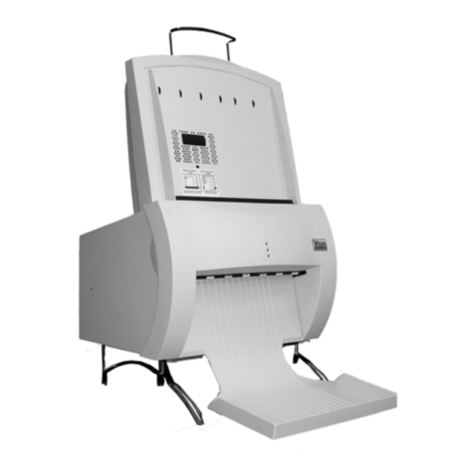
3D Systems
3D Systems VIDAR AdvantagePRO Series user guide
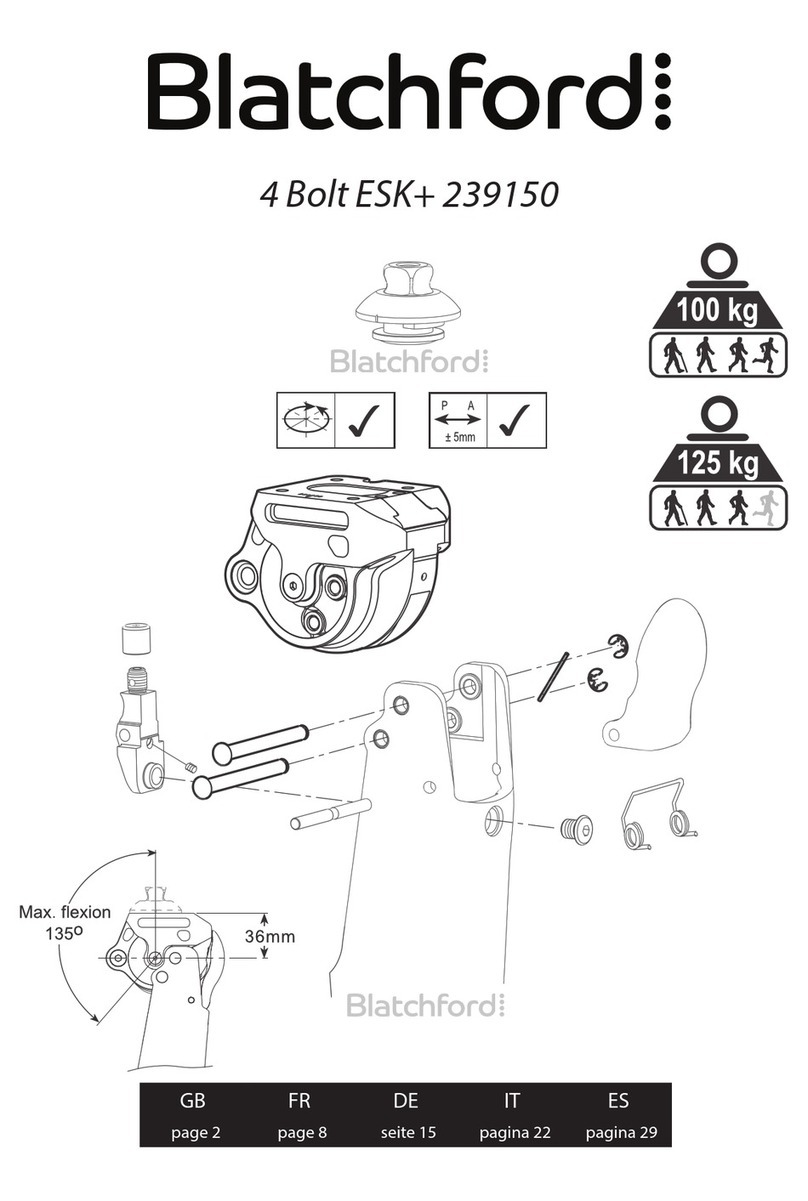
Blatchford
Blatchford 4 Bolt ESK+ 239150 manual
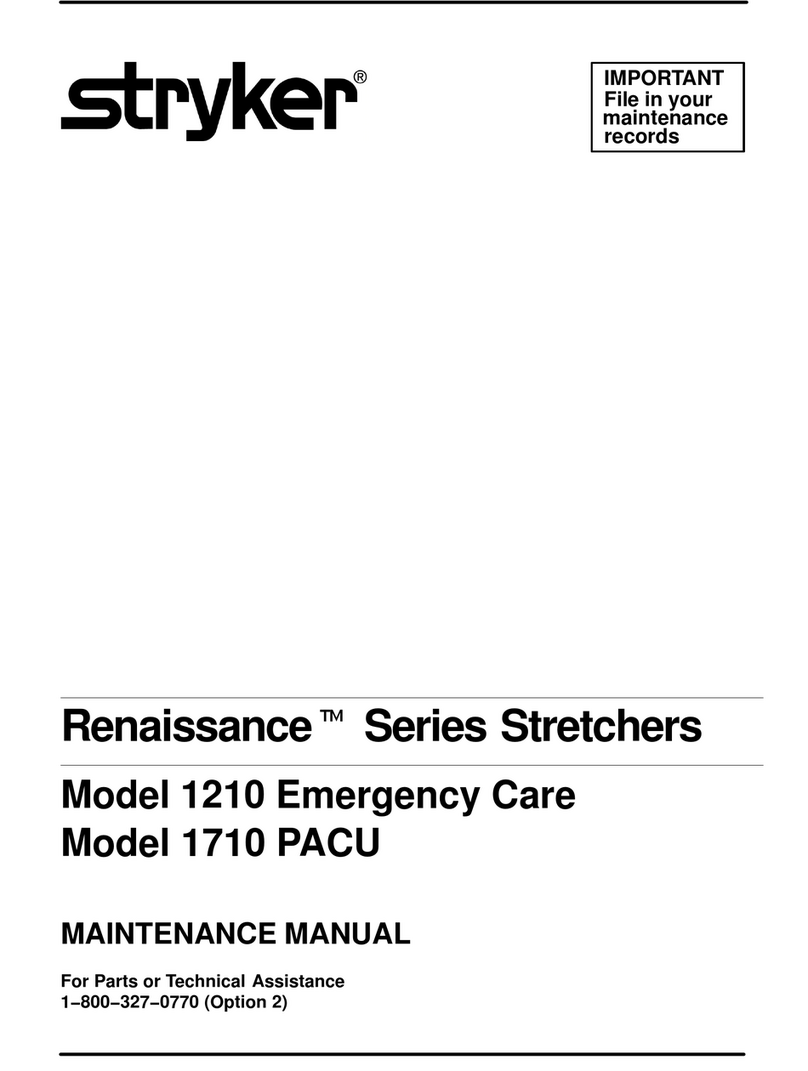
Stryker
Stryker Renaissance 1210 Maintenance manual

schwa-medico
schwa-medico MedicoBack P-type Series instruction manual

bort medical
bort medical 100 300 Instructions for use
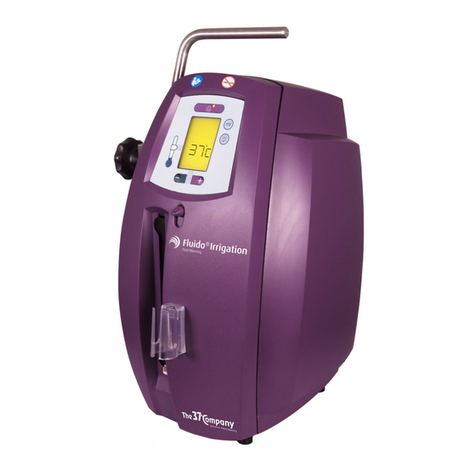
TSCI
TSCI Fluido Irrigation user manual
